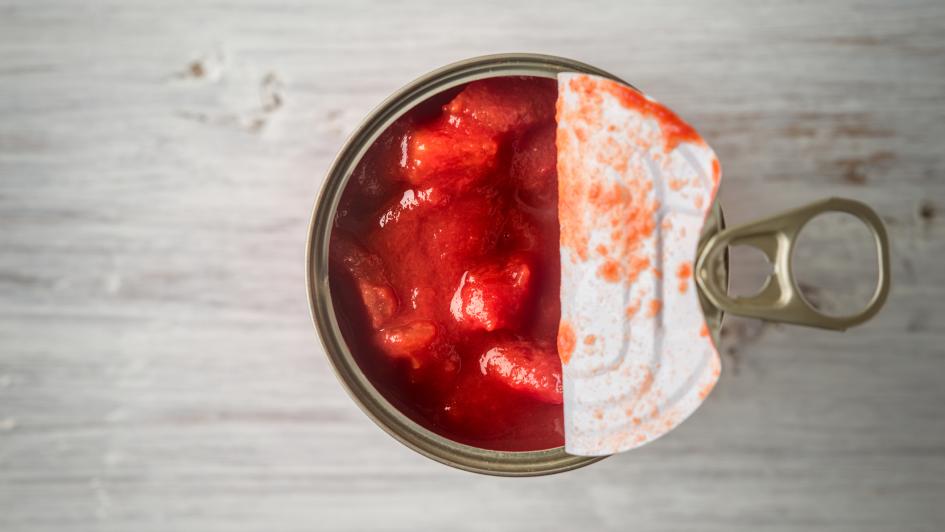Are Canned Vegetables as Healthy as Fresh?

Published
Canned vegetables are quick, convenient, and often less expensive than their fresh counterparts. While they have these advantages, are they as nutritious as fresh vegetables?
Canning fruits and vegetables allows them to be preserved so they don’t spoil and can be eaten all year round. The canning process includes heating and tightly sealing the cans to prevent bacteria growth. Sometimes flavor enhancers and preservatives like salt are also added. These steps have both a positive and negative impact on the nutrients within the vegetables, most notably on vitamin C, vitamin A, and sodium.
Vitamin C
Vegetables including tomatoes, spinach, and green beans are some of the commonly canned vegetables that are rich in vitamin C. While the initial blanching process results in some vitamin C losses, the remaining vitamin C is preserved longer after canning. During blanching, which is done by submerging vegetables into boiling water for several minutes, vitamin C is lost from heat exposure and leeching out into the water. One study showed that canned tomatoes had a 29-33% vitamin C loss compared to fresh tomatoes. While this sounds striking, it is important to consider that similar vitamin C losses would also be seen from cooking fresh tomatoes at home from heat exposure.
Canning also helps retain the remaining vitamin C in vegetables because of the absence of oxygen in the can. Unlike fresh tomatoes which lose more vitamin C the longer they are stored, canned tomatoes don’t lose a significant amount of vitamin C when they are stored for long periods of time. It has been shown that greater than 85% of vitamin C is retained in canned goods stored at room temperature for up to 1 year.
Vitamin A
Many vegetables rich in vitamin A can be found in canned form like pumpkin, spinach, peas, green beans, sweet potato, and squash. Vitamin A does not leech into cooking water like vitamin C does. It is also stands up to heat processing and storage. In fact, several studies have noted increased levels of vitamin A in canned vegetables. This may be because vitamin A becomes more accessible through canning. Therefore, choosing canned vegetables high in vitamin A can be very nutritious.
Sodium
Sodium levels are often higher in canned vegetables versus fresh because it is commonly added for flavor enhancement and increasing shelf life. According to the 2009-2012 National Health and Nutrition Examination Survey (NHANES), 90% of adults and children exceed the recommended intake of sodium. This is of concern because diets high in sodium can increase the risk of developing high blood pressure and cardiovascular disease. Fortunately, not all canned vegetables have added sodium. If canned vegetables are a major source of your diet, it is important choose “low sodium” and “no salt added” varieties to protect your heart health.
Other Considerations
Another compound to consider when choosing canned over fresh vegetables is BPA. BPA stands for bisphenol A. It is a hormone disrupting chemical that is often used in the lining of cans. It has been linked to some cancers, infertility, type 2 diabetes, and other conditions. While the FDA states that current BPA levels are considered safe in foods, it is still something to be cautious of due to the associated health risks. To minimize BPA consumption, look for “BPA free” canned goods or choose foods that are jarred in glass instead of packaged in a can.
The Biggest Takeaway
While some initial vitamin C is lost through the canning process, canning also helps to preserve remaining vitamin C and makes vitamin A more available. Additionally, by choosing “no salt added” and “BPA free” varieties, you can reduce excess consumption of these added substances. Through careful selection, you can maximize your nutrition from canned vegetables making them a healthy way to include vegetables to your diet.
About the author
Jodi Gamble holds a Master’s degree in Nutrition and Dietetics from Bastyr University and is a current dietetic intern through Bastyr University. Her aim is to empower individuals to take control of their health through an individualized approach utilizing whole foods nutrition.
References
(1) Rickman, J., Barrett, D. M., & Bruhn, C. M. (2007). Nutritional comparison of fresh, frozen and canned fruits and vegetables. Part 1. Vitamins C and B and phenolic compounds. Journal of the Science of Food and Agriculture, 87:930–944.
(2) Saccani G, Trifir´o A, Cortesi A, Gherardi S, Zanotti A and Montanari A. (2001). Effects of production technology and storage conditions on the content of water-soluble vitamins in tomato purees. Ind Conserve 76:107–118
(3) Kramer A. (1982). Effect of storage on nutritive value of food. Handbook of Nutritive Value of Processed Food, ed. by Rechcigl M. CRC Press, Boca Raton, FL, pp. 275–299.
(4) Lessin WJ, Catigani GL and Schwartz SJ. (1997). Quantification of cis–trans isomers of provitamin A carotenoids in fresh and processed fruits and vegetables. Journal of Agriculture and Food Chemistry 45:3728–3732.
(5) Rickman, J., Barrett, D. M., & Bruhn, C. M. (2007). Nutritional comparison of fresh, frozen, and canned fruits and vegetables II. Vitamin A and carotenoids, vitamin E, minerals and fiber. Journal of the Science of Food and Agriculture, 87(March 2007), 1185–1196.
(6) Jackson, S. L., King, S. M. C., Zhao, L., & Cogswell, M. E. (2016). Prevalence of Excess Sodium Intake in the United States — NHANES, 2009–2012. MMWR. Morbidity and Mortality Weekly Report, 64(52), 1393–1397. doi: 10.15585/mmwr.mm6452a1.
(7) Diamanti-Kandarakis, E., Bourguignon, J. P., Giudice, L. C., Hauser, R., Prins, G. S., Soto, A. M., Gore, A. C. (2009). Endocrine-disrupting chemicals: an Endocrine Society scientific statement. Endocrine reviews, 30(4), 293–342. doi:10.1210/er.2009-0002


